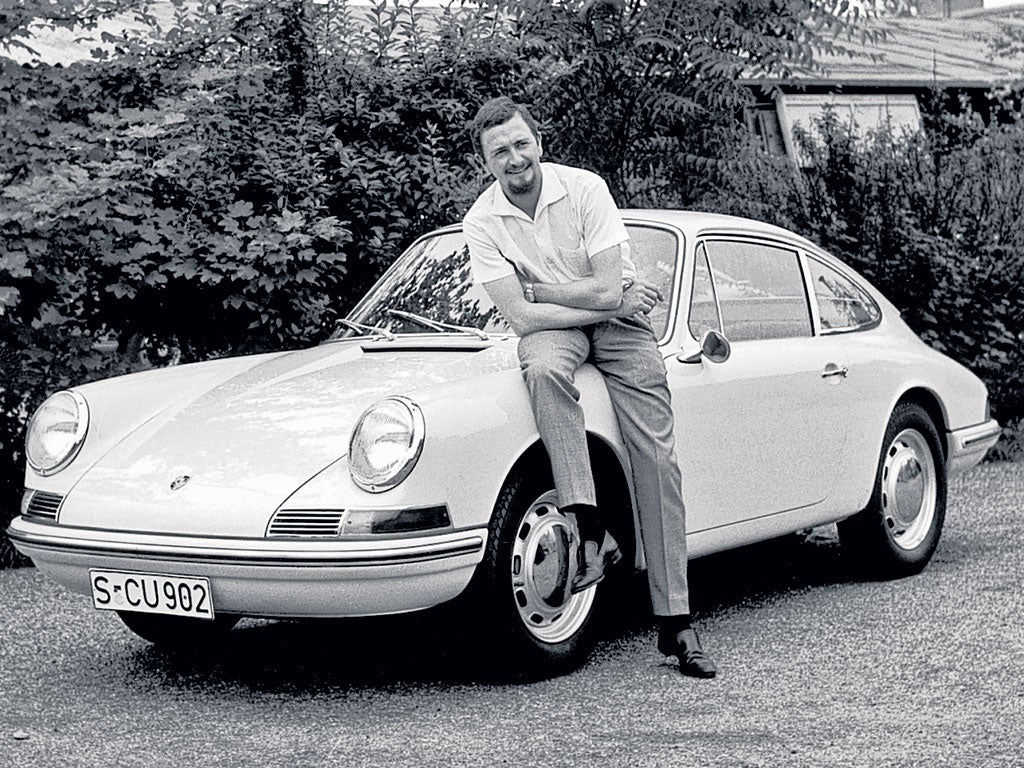Ferdinand Porsche: Designer who made his name with the 911 and 904 Carrera GTS sports cars
After his career designing cars, he turned to luxury goods, including a Blackberry phone priced at £1,275

Ferdinand Porsche, designer of the Porsche 911 and the beautifully crafted and highly successful Porsche 904 Carrera GTS, went on to establish his own prestigious design company, which also carries the family name. Having joined the company in 1958, "FA", as he was known to colleagues, took over as head of the company's design studio in 1962, when he was 27.
The 911's roots lay in sketches drawn by Porsche in 1959. With more rear-seat room and bigger doors for easier access, it was developed as a more powerful, larger and more comfortable sibling of Porsche's much-loved first model, the four-cylinder 356. Porsche worked on the chassis and body while his cousin Ferdinand Piech developed the rear-mounted six-cylinder engine. With a slightly longer wheelbase and aerodynamic body shape, the new-generation Porsche was unveiled at the Frankfurt Auto Show in 1963 as the Porsche 901. However, the French competitor Peugeot claimed a patent on all three-digit car names with a zero in the middle, and with a change of a number the fabled "911" was born. Its elegance and the simplicity of its shape quickly made it a classic.
Production began in September 1964; only 45 are known to exist. Now in its seventh incarnation, the 911 remains recognisably the same vehicle, with its sloping roofline, long, low hood and prominent headlights; it was recently voted one of the best cars of the 20th century.
Manny Alban, president of the 106,000-member Porsche Club of America and owner of two 1990 911s, compares the design to the Coca-Cola bottle, an outline instantly familiar even to those who are not aficionados. "It's very German," he said. "Everything has a purpose, every button, it all makes sense. There are no gizmos. You won't look back 20 years later and say 'why did they put that on there?'."
The former Porsche designer Freeman Thomas recalled being "smitten and inspired" by the 911 in the 1960s, adding that Ferdinand's design philosophy influenced his work when he designed the Audi TT sports car.
Born in Stuttgart in December 1935, Ferdinand Alexander "Butzi" Porsche was the oldest of four sons of Dorothea and Ferdinand "Ferry" Porsche. As a child he enjoyed designing and building his own toys and spent hours in his grandfather's workshops and design facilities in Zuffenhausen. Ferdinand studied design at the Hochschule fur Gestaltung in Ulm before joining Porsche in 1958.
The company, originally founded by Ferdinand's grandfather, also Ferdinand, in 1931, initially offered development and consultancy work and did not build any cars under its own name. Following Hitler's rise to power in 1933, one of the company's first assignments was to build a "car for the people", a Volkswagen. This resulted in the VW Beetle, one of the most successful car designs of all time. The Porsche 64 was developed in 1939 using many components from the Beetle. During the Second World War Porsche was involved in the design of the Kübelwagen, a military version of the Beetle and designs for the Tiger tank.
It was Ferry Porsche who had turned his father's business from an engineering and design company into a manufacturer as well. He designed its first product, a lightweight rear-engine roadster, the Porsche 356, which was introduced in 1948 and put into wide production in 1950.
Soon after the 911 came the 904 Carrera GTS. Having retired from Formula One at the end of the 1962 season, the company focused again on sports car racing. Designed by Ferdinand, the 904 anticipated, from a technical point of view, much that later became the norm in racing car manufacturing: mixed steel/fibreglass reinforced resin construction, low weight, small frontal area. It was also the first Porsche with a plastic body. Porsche designed the GTS variant to compete in the FIA-GT class; the street-legal version debuted in 1964 and demand outstripped supply.
Five months after it was launched, Porsche achieved its fifth victory in the classic Targa Florio endurance race in April 1964 with a production 904. Further victories followed including the Tour de France, the 1,000 kilometre race at the Nürburgring, the Le Mans 24-hour race and the Reims 24-hour race, while it came in second in the 1965 Monte Carlo Rally despite a snow-covered course. And to the Americans' surprise Porsche claimed the C-Production and E-Sports Racing titles from SCCA. The 904, fitted with four, six and eight-cylinder engines was not only a hugely successful racing car, but is still regarded as one of the most attractive.
Porsche left the operational side of the company with other family members in 1972 and founded the design business, Porsche Design Studio, which moved two years later from Germany to Zell-am-See in Austria. The studio created mostly high-end men's accessories with the Porsche branding, including sunglasses, watches and pens, and worked on a variety of industrial products, household appliances and consumer goods for other companies, including a smartphone for Blackberry (priced at an eye-watering £1,275). As a designer, he stressed function over decoration: "A formally coherent product needs no decoration. It should be elevated through pure form."
Porsche served as chairman of Porsche AG from 1990-93 and helped steer the family firm through a crisis as sales plunged in the late 1980s under pressure from global competition and a strong German mark that hindered exports. Under his chairmanship, the company brought in a chief executive, Wendelin Wiedeking, who turned the company around.
Ferdinand Porsche, car designer: born Stuttgart 11 December 1935; died Salzburg 5 April 2012.
Subscribe to Independent Premium to bookmark this article
Want to bookmark your favourite articles and stories to read or reference later? Start your Independent Premium subscription today.

Join our commenting forum
Join thought-provoking conversations, follow other Independent readers and see their replies